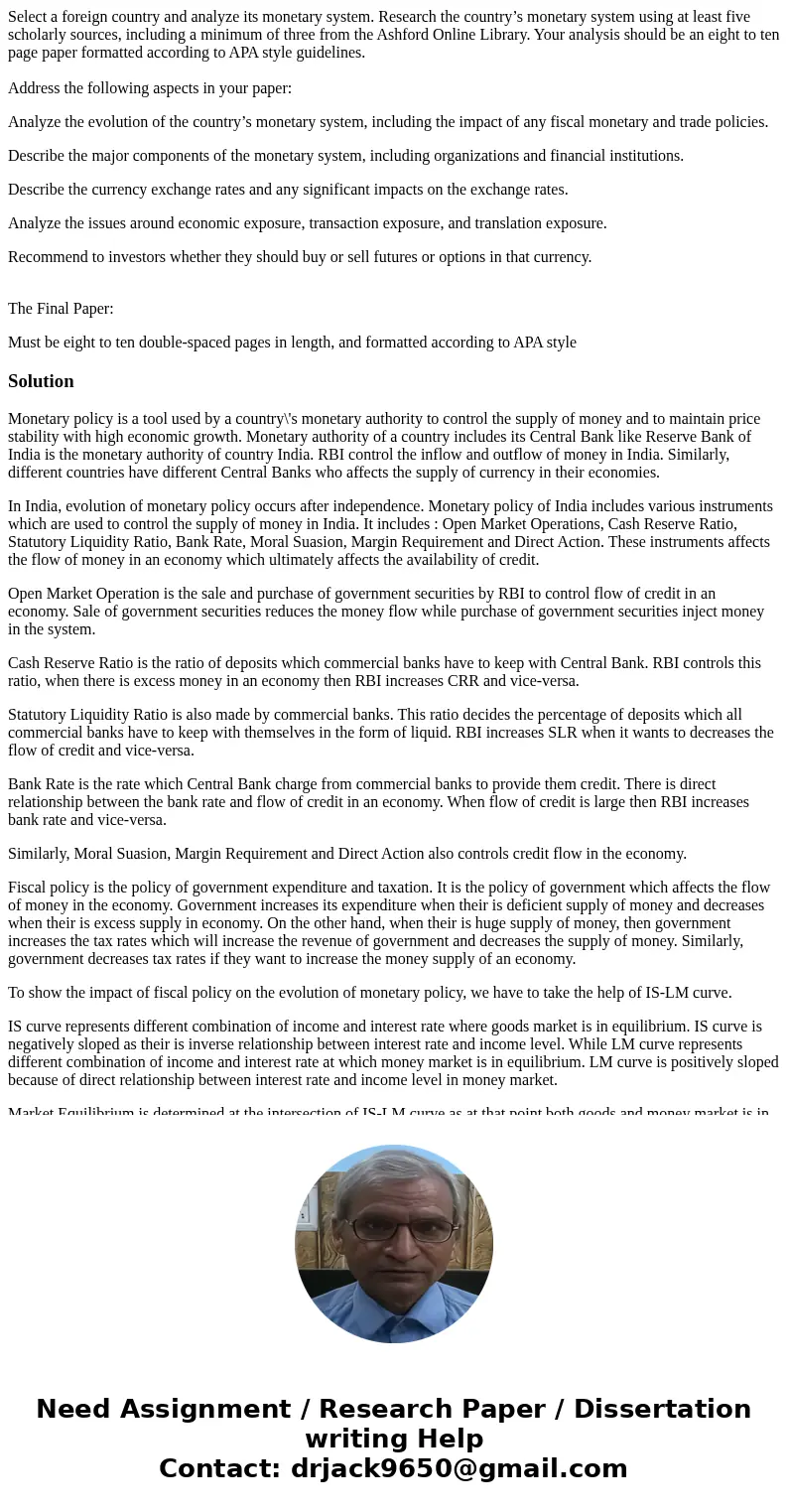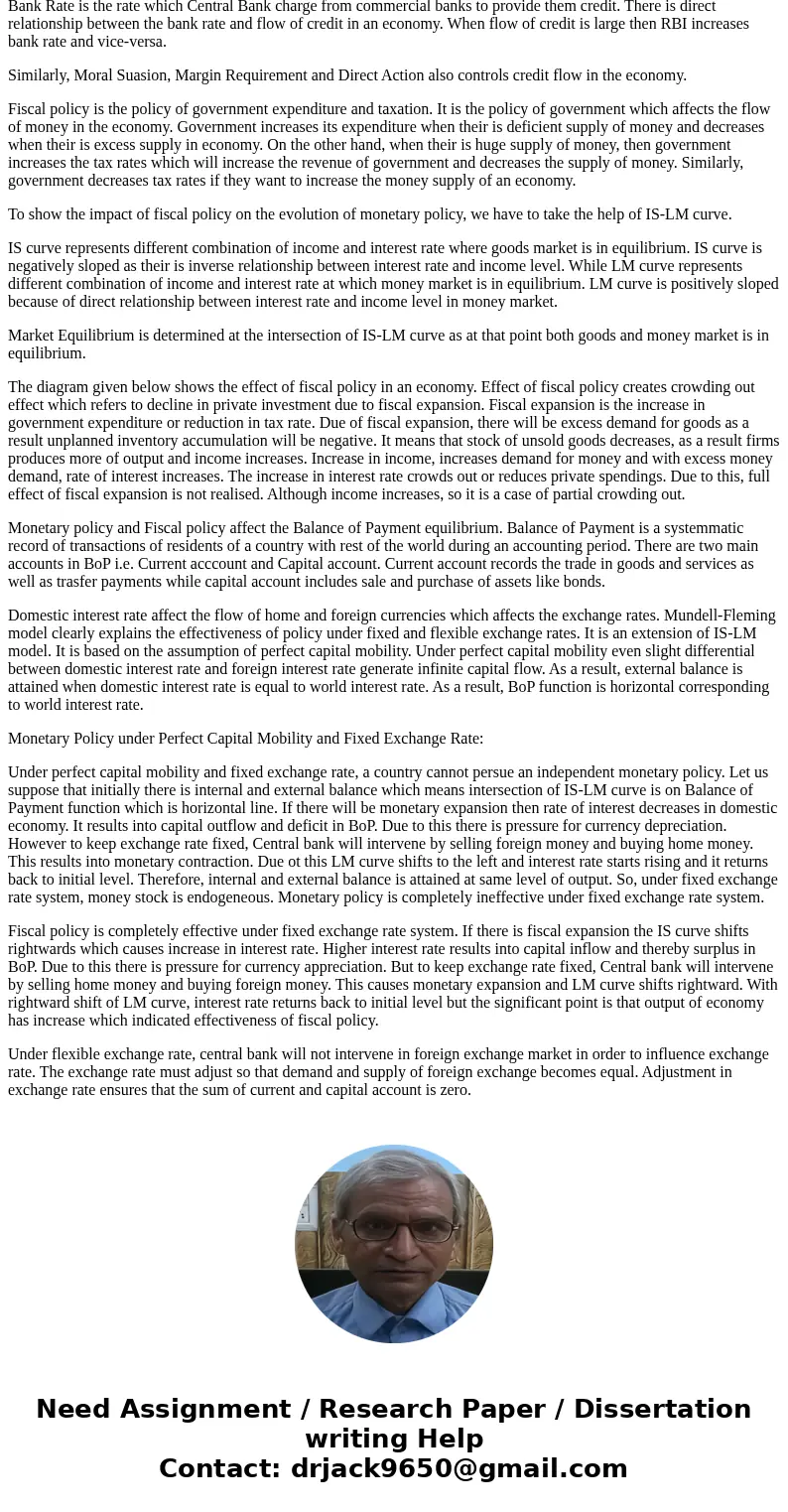Select a foreign country and analyze its monetary system Res
Select a foreign country and analyze its monetary system. Research the country’s monetary system using at least five scholarly sources, including a minimum of three from the Ashford Online Library. Your analysis should be an eight to ten page paper formatted according to APA style guidelines.
Address the following aspects in your paper:
Analyze the evolution of the country’s monetary system, including the impact of any fiscal monetary and trade policies.
Describe the major components of the monetary system, including organizations and financial institutions.
Describe the currency exchange rates and any significant impacts on the exchange rates.
Analyze the issues around economic exposure, transaction exposure, and translation exposure.
Recommend to investors whether they should buy or sell futures or options in that currency.
The Final Paper:
Must be eight to ten double-spaced pages in length, and formatted according to APA style
Solution
Monetary policy is a tool used by a country\'s monetary authority to control the supply of money and to maintain price stability with high economic growth. Monetary authority of a country includes its Central Bank like Reserve Bank of India is the monetary authority of country India. RBI control the inflow and outflow of money in India. Similarly, different countries have different Central Banks who affects the supply of currency in their economies.
In India, evolution of monetary policy occurs after independence. Monetary policy of India includes various instruments which are used to control the supply of money in India. It includes : Open Market Operations, Cash Reserve Ratio, Statutory Liquidity Ratio, Bank Rate, Moral Suasion, Margin Requirement and Direct Action. These instruments affects the flow of money in an economy which ultimately affects the availability of credit.
Open Market Operation is the sale and purchase of government securities by RBI to control flow of credit in an economy. Sale of government securities reduces the money flow while purchase of government securities inject money in the system.
Cash Reserve Ratio is the ratio of deposits which commercial banks have to keep with Central Bank. RBI controls this ratio, when there is excess money in an economy then RBI increases CRR and vice-versa.
Statutory Liquidity Ratio is also made by commercial banks. This ratio decides the percentage of deposits which all commercial banks have to keep with themselves in the form of liquid. RBI increases SLR when it wants to decreases the flow of credit and vice-versa.
Bank Rate is the rate which Central Bank charge from commercial banks to provide them credit. There is direct relationship between the bank rate and flow of credit in an economy. When flow of credit is large then RBI increases bank rate and vice-versa.
Similarly, Moral Suasion, Margin Requirement and Direct Action also controls credit flow in the economy.
Fiscal policy is the policy of government expenditure and taxation. It is the policy of government which affects the flow of money in the economy. Government increases its expenditure when their is deficient supply of money and decreases when their is excess supply in economy. On the other hand, when their is huge supply of money, then government increases the tax rates which will increase the revenue of government and decreases the supply of money. Similarly, government decreases tax rates if they want to increase the money supply of an economy.
To show the impact of fiscal policy on the evolution of monetary policy, we have to take the help of IS-LM curve.
IS curve represents different combination of income and interest rate where goods market is in equilibrium. IS curve is negatively sloped as their is inverse relationship between interest rate and income level. While LM curve represents different combination of income and interest rate at which money market is in equilibrium. LM curve is positively sloped because of direct relationship between interest rate and income level in money market.
Market Equilibrium is determined at the intersection of IS-LM curve as at that point both goods and money market is in equilibrium.
The diagram given below shows the effect of fiscal policy in an economy. Effect of fiscal policy creates crowding out effect which refers to decline in private investment due to fiscal expansion. Fiscal expansion is the increase in government expenditure or reduction in tax rate. Due of fiscal expansion, there will be excess demand for goods as a result unplanned inventory accumulation will be negative. It means that stock of unsold goods decreases, as a result firms produces more of output and income increases. Increase in income, increases demand for money and with excess money demand, rate of interest increases. The increase in interest rate crowds out or reduces private spendings. Due to this, full effect of fiscal expansion is not realised. Although income increases, so it is a case of partial crowding out.
Monetary policy and Fiscal policy affect the Balance of Payment equilibrium. Balance of Payment is a systemmatic record of transactions of residents of a country with rest of the world during an accounting period. There are two main accounts in BoP i.e. Current acccount and Capital account. Current account records the trade in goods and services as well as trasfer payments while capital account includes sale and purchase of assets like bonds.
Domestic interest rate affect the flow of home and foreign currencies which affects the exchange rates. Mundell-Fleming model clearly explains the effectiveness of policy under fixed and flexible exchange rates. It is an extension of IS-LM model. It is based on the assumption of perfect capital mobility. Under perfect capital mobility even slight differential between domestic interest rate and foreign interest rate generate infinite capital flow. As a result, external balance is attained when domestic interest rate is equal to world interest rate. As a result, BoP function is horizontal corresponding to world interest rate.
Monetary Policy under Perfect Capital Mobility and Fixed Exchange Rate:
Under perfect capital mobility and fixed exchange rate, a country cannot persue an independent monetary policy. Let us suppose that initially there is internal and external balance which means intersection of IS-LM curve is on Balance of Payment function which is horizontal line. If there will be monetary expansion then rate of interest decreases in domestic economy. It results into capital outflow and deficit in BoP. Due to this there is pressure for currency depreciation. However to keep exchange rate fixed, Central bank will intervene by selling foreign money and buying home money. This results into monetary contraction. Due ot this LM curve shifts to the left and interest rate starts rising and it returns back to initial level. Therefore, internal and external balance is attained at same level of output. So, under fixed exchange rate system, money stock is endogeneous. Monetary policy is completely ineffective under fixed exchange rate system.
Fiscal policy is completely effective under fixed exchange rate system. If there is fiscal expansion the IS curve shifts rightwards which causes increase in interest rate. Higher interest rate results into capital inflow and thereby surplus in BoP. Due to this there is pressure for currency appreciation. But to keep exchange rate fixed, Central bank will intervene by selling home money and buying foreign money. This causes monetary expansion and LM curve shifts rightward. With rightward shift of LM curve, interest rate returns back to initial level but the significant point is that output of economy has increase which indicated effectiveness of fiscal policy.
Under flexible exchange rate, central bank will not intervene in foreign exchange market in order to influence exchange rate. The exchange rate must adjust so that demand and supply of foreign exchange becomes equal. Adjustment in exchange rate ensures that the sum of current and capital account is zero.


 Homework Sourse
Homework Sourse